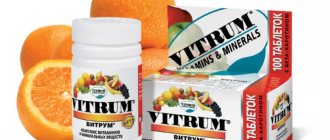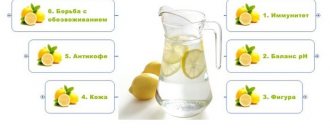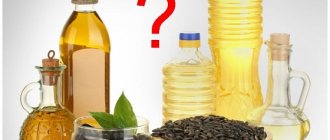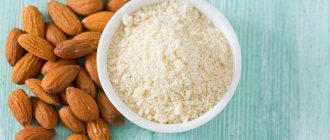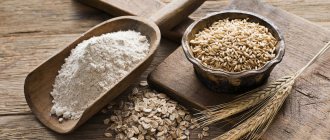The pursuit of vitamins has become part of the current fashion for a healthy lifestyle. Is it true that vitamins sold in pharmacies are beneficial to the body?
Like 11
27542
Vitamin deficiency is detrimental to health—a well-known fact. Those who fell ill first of all were those whose diets had lost some very important substances... As a result, we have the following picture: of the 40 vitamins discovered today, 12 are the most important in nutrition.
In the mid-1980s, the World Health Organization conducted a large-scale study, finding that Mediterranean residents suffer and die from cardiovascular diseases significantly less than the European population as a whole. The reason for this is different diets. Mediterranean people eat much more fresh vegetables and fruits.
- 178
More details - 222
More details
- 262 218
More details
- 570
More details
This fact - a decrease in heart and vascular diseases in regions rich in fruits and vegetables - has given rise to a multivitamin boom. Immediately there were researchers who almost equated vitamins C and E, as well as provitamin A, to drugs for heart disease.
The pharmaceutical industry immediately increased its capacity tenfold, and the people increased their spending on miracle drugs. Fortunately, they don’t even require prescriptions from pharmacies.
History of vitamin discovery
The history of the discovery of vitamins begins in ancient times.
Even healers and shamans noticed that some herbs, vegetables and fruits help a person recover from diseases. In ancient Egypt, liver was used to cure night blindness. In 1330, the Chinese scientist Hu Sihuen noted that to improve health, the menu should be rich. In 1747, it was discovered that scurvy could be prevented by eating citrus fruits.
Towards the end of the 19th century. people assessed the nutritional value of foods based on the content of proteins, fats and carbohydrates. However, this did not help cope with scurvy, which necessitated additional research. The Russian scientist N.I. Lunin began the experiments. He divided the mice into 2 groups and began to feed them different milk: natural and artificial. The latter contained only sugars, fats, caseins, proteins and minerals.
Mice fed artificial milk died. This prompted N.I. Lunin to think that the products contained some other unknown beneficial substances, but his discovery was not accepted by the scientific community.
Experiments were carried out on mice.
They returned to full-fledged research only in 1911. A scientist from Poland, Casimir Funk, was able to isolate an unknown crystalline substance in its pure form.
A small amount of this compound helped get rid of beriberi disease, which was caused by a lack of B1. The substance was called a vitamin. Translated from Latin, vita means life, and amine is a compound that contains nitrogen.
What are they and how to determine their deficiency?
Schoolchildren also know that the most beneficial substances are found in vegetables and fruits. Many people believe that eating them daily is enough to supply vitamins. But modern research shows that even fresh and green foods do not always provide the right amount of vital elixirs.
Vegetables grown in a greenhouse lose some of their properties. They also decrease with long-term transportation and storage in warehouses. The consumer often uses their beautiful shell without useful substances. Often the properties of vitamins are destroyed by heat treatment, sunlight and air. This leads to their oxidation and destruction. Canned foods also change their properties. Storing them for a long time in the freezer also leads to the volatilization of vitamins.
Vitamin deficiency occurs as a pronounced deficiency, when the body itself “screams” about their lack. This manifests itself in interruptions in metabolism. Also, the deficiency is immediately determined by analysis. The body begins to draw supplies from reserves and functions at the limit of its capabilities. Even with a sudden resumption of the supply of vitamins, a failure may occur. This is especially true in winter and spring. A similar picture is noticeable by how you don’t want to get out of bed, have no appetite, and have no strength to work. The lack of vital elixirs is not a runny nose or allergies, but absent-mindedness, the desire to drink a cup of coffee in the morning to restore strength, and rapid fatigue. Therefore, many people want to know how often they can take vitamins. By the way, not everyone knows that coffee can aggravate vitamin deficiency, because it washes out beneficial substances in the urine.
Here are some other signs of vitamin deficiency:
- A red, purple tongue indicates a lack of vitamin B1.
- A polished tongue with a slight tingling indicates a lack of B12.
- Cracks or seizures in the corners of the mouth, seborrhea, leg cramps - lack of B2 or B6.
- Burning in the feet - it's time to take B3.
- Weakness, goose bumps, tingling in the legs - lack of vitamin B12.
- Too cold or warm feet indicate B1 deficiency.
- Brittle nails, white stripes on the plates - take vitamin D and A.
- Decreased vision (“night blindness”) - lack of substance A.
The role of vitamins in the human body
Vitamins are required to ensure almost all vital functions of cells, tissues and internal organs.
The human body spends several hundred mg of nutrients from this group every day to maintain its functioning. The main task of vitamins is to normalize metabolism and create favorable conditions for the occurrence of chemical and physiological processes.
What are vitamins for?
Vitamins are required for the correct functioning of the immune, digestive, cardiovascular, genitourinary, and nervous systems. They are involved in the synthesis of blood cells. Nutrients are required for the secretion of enzymes and hormones. With a sufficient concentration of nutrients, the body receives protection from radionuclides and toxins.
Vitamins are needed for the normal functioning of the body.
Types of vitamins and their effect on humans
There are water- and fat-soluble vitamins. Their effect depends on the type of substance.
For example, retinol supports visual health. Calciferols are required to strengthen bone tissue.
Seniors need more!
Many of us approach a certain age with a baggage of diseases that require additional vitamin support. Many older people adhere to one diet or another, which also impoverishes their diet.
Plus vitamins are one of those substances that protect the structure of DNA from changes under the influence of external factors. It is vitamins that help deactivate altered sections of DNA or, conversely, support the functioning of important genes. For example, B vitamins take part in “turning off” certain genes (they are involved in attaching methyl groups to DNA, which leads to modification of the DNA molecule). This process is important at the initial stage of development of any organism, when cells are divided according to their functions. If a pregnant woman does not receive enough vitamins B12 or B9, this can cause fetal development problems. With age, the absorption of B vitamins in the intestines deteriorates. This, in turn, can “turn off” certain genes that prevent the development of age-related diseases. That is why a sufficient amount of B vitamins is important at any age, but especially in old age. Another example: in order to maintain the activity of important sections of DNA, for example, those responsible for cell division and renewal, vitamins A, C, and iron are important.
Question answer
What is a vitamin?
Fat-soluble vitamins
Fat-soluble vitamins include retinol, calciferol, tocopherol and phylloquinone.
Features of fat-soluble vitamins
This group of vitamins is absorbed more slowly than water-soluble ones. They tend to accumulate in the body. Excesses are not excreted, so there is a risk of developing hypervitaminosis. When taken in large doses, fat-soluble vitamins become toxic. The body does not use substances from this group constantly, so reserves are stored in adipose tissue and the liver. Fat-soluble nutrients are relatively stable and are not destroyed when food is cooked.
A (retinol)
Retinol is an antioxidant. Supports healthy skin and vision. Vitamin A is a natural immunostimulant. Helps the body destroy bacteria, fungi and viruses.
Retinol is a fat-soluble vitamin and antioxidant.
Groups D
Calciferol helps maintain normal calcium concentrations in the body. This helps strengthen bone tissue. With sufficient calciferol intake, the risk of developing osteoporosis is reduced.
E (tocopherol)
Tocopherol is a natural antioxidant. It protects cells from the effects of free radicals. Vitamin E contributes partly to cancer prevention. Slows down aging. Taking it has a beneficial effect on the condition of the skin.
Tocopherol is a universal protector of the cell membrane.
K (phylloquinone, naphthoquinone)
Phylloquinone helps regulate blood clotting levels. Additionally supports heart and intestinal health. Overdose and deficiency of the vitamin are dangerous for humans: in the first case, the body stops coping with blood circulation, in the second, there is a high probability of bleeding.
What are vitamins?
Vitamins (lat. vita life + amines) are low-molecular organic compounds of various chemical natures, which are extremely necessary for the normal functioning and development of the body, since they are part of a large number of enzymes and hormones, stimulate the body’s protective capabilities, its growth, differentiation and morphogenesis. They are essential nutrients, because... With the exception of nicotinic acid, they are not synthesized by the human body and come mainly as part of food, especially with vegetables, fruits, milk, liver, etc.
Along with vitamins, a group of vitamin-like compounds is known. These include choline, inositol, orotic and lipoic acids, carnitine, bioflavonoids and a number of other compounds that have certain properties of vitamins. Vitamin-like compounds do not, however, have all the basic properties of vitamins.
The human body is not able to store vitamins for a more or less long period of time; they must be supplied regularly, in full and in accordance with physiological needs. At the same time, the adaptive capabilities of the body are quite large, and over a long period of time, vitamin deficiency practically does not appear: vitamins deposited in organs and tissues are consumed, and other compensatory metabolic mechanisms are activated. Only after the deposited vitamins are used up do various metabolic disorders occur. However, constant insufficient consumption of vitamins, even if not characterized by any clinical manifestations of hypovitaminosis, negatively affects a person’s health: well-being worsens, performance and resistance to respiratory and infectious diseases decrease, and the body’s exposure to unfavorable environmental factors increases.
Insufficient dietary intake of certain vitamins (especially A and C) is a risk factor for the development of coronary heart disease and a number of malignant neoplasms. In particular, long-term studies conducted by English and American specialists have shown that the incidence of cancer of the oral cavity, gastrointestinal tract and lungs with low levels of vitamin A in the blood is 2-4 times higher than with an optimal supply of this vitamin.
An important role in providing the body with vitamins is traditionally assigned to enriching the diet with fresh vegetables and fruits. However, their consumption inevitably has seasonal restrictions. In addition, vegetables and fruits are only a source of vitamin C, folate and carotenes. At the same time, the main sources of B vitamins are black bread and meat and dairy products, the main source of vitamin A is butter, and vitamin E is vegetable fats. Thus, correction of the vitamin value of the diet using natural products inevitably leads to an excessive increase in its calorie content, which is a risk factor for coronary heart disease, hypertension, diabetes mellitus and a number of other diseases, the prevention of which requires, on the contrary, a reduction in the calorie content of the diet in accordance with reduced energy consumption modern man.
One of the effective ways to ensure optimal consumption of vitamins without increasing the calorie content of the diet is the inclusion of fortified food products: bread made from fortified flour, enriched with vitamins B1, B2 and PP, milk, kefir, juices and drinks fortified with vitamin C, and a number of others. The content of vitamins in these products is regulated at such a level as to meet the physiological needs of humans; it is indicated on the packaging and is controlled by state sanitary inspection authorities. Fortification can also be carried out by introducing vitamins into food immediately before consumption.
Water-soluble vitamins
Water-soluble vitamins include ascorbic acid and group B.
Properties of water-soluble vitamins
Water-soluble vitamins are found mainly in foods of animal origin. They are constantly used by the body and are easily absorbed from foods. Excesses freely leave the tissues and gastrointestinal tract. Water-soluble vitamins are required to utilize other nutrients.
B1 (thiamine)
Thiamine is required for proper metabolism. It is involved in the metabolism of amino acids, lipids and carbohydrates. Without it, cells would not receive nutrients and energy. Thiamine promotes the proper functioning of the nervous system. Improves blood circulation and activates brain activity.
Thiamine is a water-soluble vitamin.
B2 (riboflavin)
Riboflavin is called the beauty vitamin. It improves the condition of hair, nails and skin. Riboflavin is necessary for the formation of blood cells and antibodies. Required for children to grow. Vitamin B2 is needed for the functioning of the reproductive system. Normalizes the activity of the thyroid gland.
With a lack of riboflavin, iron absorption is impaired. The vitamin is needed for correct color perception and rapid adaptation of the visual organs to changes in brightness.
B3 (nicotinic acid, niacin, vitamin PP)
Nicotinic acid dilates blood vessels and improves blood circulation. Thanks to it, all tissues and internal organs receive more nutrients. This promotes regeneration and cell division. Niacin takes part in the formation of hormones, it affects the condition of the heart, organs of vision, skin and mucous membranes.
Niacin is a vitamin involved in many oxidative reactions.
B5 (pantothenic acid)
Pantothenic acid activates hormone synthesis. The vitamin is used in the treatment of gastrointestinal diseases. It normalizes the course of oxidative processes.
With sufficient concentration of the substance, aging slows down. Brain function improves.
B6 (pyridoxine)
Pyridoxine is involved in metabolism. Promotes the absorption of lipids and amino acids. Fights premature aging. Helps control muscles and has a beneficial effect on their tone. If the compound is deficient, the risk of spasms and seizures increases.
Pyridoxine plays an important role in metabolism.
B7 (biotin)
Biotin is required for normal metabolism. Helps synthesize lipids and glycogen, takes part in protein metabolism, promotes cell growth.
Improves the condition of skin and hair. Creates conditions for the development of beneficial microflora in the intestines.
B9 (folic acid)
Folic acid is required for the synthesis of RNA and DNA. It is a building material for the body. Necessary for creating the genetic code. With a deficiency of folic acid, the division and growth of new cells is impossible. Primarily, the mucous membranes of the gastrointestinal tract, skin, immune system and bone marrow are affected. With vitamin deficiency, anemia may develop.
Folic acid is a water-soluble vitamin.
B12 (cyanocobalamin)
Cyanocobalamin is required for the correct growth of red blood cells. It is needed for the formation of nerve endings. Participates in metabolism, helps absorb fats. Cyanocobalamin ensures correct cell division. Increases a person's concentration level and improves mood.
C (ascorbic acid)
Ascorbic acid is a natural antioxidant. Activates the immune system, protects the body from viruses and bacteria, accelerates wound healing. Thanks to the vitamin, hematopoietic processes are normalized. Ascorbic acid regulates the functioning of the thyroid gland.
Ascorbic acid is not formed in the human body, but comes only from food.
Ascorbic acid is not formed in the human body, but comes only from food.
Are vitamins3 harmful?
Before consuming dietary supplements, you need to find out which vitamins are useful and which can cause serious harm to the body. Thus, natural vitamin A does not exist in the form of tablets; pharmacists have only learned to synthesize a separate element - beta-carotene. This compound is extremely necessary for the eyes, however, if you use it often and thoughtlessly, you can get extremely negative consequences - the likelihood of developing intestinal cancer increases. If a person also smokes, the risk of developing heart disease increases.
Even with an excess of natural vitamin A, adverse effects can occur - dizziness, nausea, so any type of supplement should be used with extreme caution.
With vitamin C, too, everything is not as simple as it seems. People are used to calling it “ascorbic acid” and swallowing it like candy, however, vitamin C contains various elements, an overdose of which contributes to the development of atherosclerosis and even increases the likelihood of a person’s premature death.
Vitamin D is formed in the human body under the influence of sunlight. An excess of this vitamin is very dangerous for children, since the skull stops growing, while the brain increases in size, which causes extremely unpleasant consequences.
Vitamin-like substances
Vitamin-like substances are organic compounds that resemble vitamins, but unlike them, can be synthesized by the body.
B4 (choline)
Choline is needed for phospholipid metabolism. It regulates the activity of the central nervous system. The vitamin is required for the formation of the protective myelin sheath, which is responsible for brain function. Choline helps control blood cholesterol levels.
Choline is the most important building material of the brain.
B8 (inositol)
The substance prevents the development of atherosclerosis by controlling blood cholesterol levels. The compound normalizes the functioning of the gastrointestinal tract and strengthens the walls of capillaries and blood vessels.
Inositol is of particular importance for women: with its deficiency, egg division does not occur.
Para-aminobenzoic acid
Para-aminobenzoic acid is required for the absorption of folic acid.
B10 (aminobenzoic acid)
Aminobenzoic acid regulates the activity of the thyroid gland. Normalizes metabolism and prevents the formation of blood clots. If there is a lack of substance, the condition of hair and skin worsens.
Choline is the most important building material of the brain.
B11 (levocarnitine)
Levocarnitine helps you lose weight, reduces the harmful effects of free radicals and protects the body from toxins.
Improves the functioning of the heart muscle and reduces cholesterol levels in the blood.
B13 (orotic acid)
Orotic acid is needed for the reproduction of DNA and RNA chains. Its sufficient consumption prevents early aging. Required for the correct functioning of the reproductive system.
Choline is the most important building material of the brain.
B15 (pangamic acid)
Pangamic acid normalizes fat metabolism and helps reduce bad cholesterol levels. Thanks to the substance, the lifespan of cells increases. Promotes their rapid regeneration.
B17 (amygdalin)
Amygdalin is required for the normal functioning of the immune system. Relieves inflammation and reduces pain. Fights depression and neuroses. It is sometimes used for weight loss.
Amygdalin is a concentrated form of vitamin B17.
Lecithins
Lecithins promote rapid recovery of the body after stress. This applies to both mental and physical stress. The substances help remove toxins from tissues and cells and normalize liver function.
P (rutin - bioflavonoids)
Rutin strengthens blood vessels and capillaries. Prevents bleeding gums. Complexes with the compound are used for the prevention of ARVI.
Rutin is a vitamin P whose indications for use are very diverse.
Coenzyme Q10 (ubiquinone)
The coenzyme is required for metabolism and energy production by the body. Serves as an antioxidant and protects tissues from oxidation.
N (lipoic acid)
Lipoic acid improves fat metabolism. Prevents intoxication, reduces blood glucose levels and improves the functioning of the central nervous system and thyroid gland.
Lipoic acid is a chemical similar to insulin.
Bioflavonoids
Bioflavonoids reduce the fragility and permeability of capillaries, which partially helps relieve inflammation. With adequate consumption, the risk of developing heart disease is reduced.
Biotin
Biotin helps produce glucose from nutrients. This helps the body get enough energy.
Biotin is a water-soluble B vitamin.
U (methionine)
Methionine promotes the healing of gastrointestinal ulcers. Normalizes the level of acidity in the stomach and intestines, reduces the severity of allergic reactions, neutralizes inflammation.
Kholin
Choline promotes rapid liver regeneration. Complexes with it are prescribed for atherosclerosis. The substance helps to lose weight by normalizing lipid metabolism.
Choline is a substance that has a number of beneficial effects.
F (unsaturated fatty acids)
Unsaturated fatty acids are used by the body as building materials and a source of energy. Supports healthy skin, hair and nails.
Is overdoing it the cause of cancer?
We have known since childhood that a lack of vitamins is harmful to health. But recently, more and more information has appeared that excess vitamins (hypervitaminosis) can also lead to the development of various diseases, including cancer. Nowadays it is not difficult to find special vitamin complexes, for example for athletes, that contain doses several times higher than the daily requirement for vitamins. Such additives must be treated with great caution.
Ideally, it is the prerogative of the doctor to prescribe vitamins. In each specific case, the individual characteristics of the person are taken into account (lifestyle, history of allergies, gastrointestinal diseases, vitamin absorption disorders). In particular, taking prophylactic doses of vitamin C in case of erosive gastritis can seriously aggravate the situation. And with long-term use in high doses, ascorbic acid often causes the development of urolithiasis. The development of arthrosis or arthritis can also be triggered by excess vitamin C - its metabolic products accumulate in the joints. Moreover, even if the doctor discovers an increased amount of vitamin C in the diet and adjusts its amount, only some patients will find relief. For others, the disease, once started, will continue to develop.
Not just oranges. 10 Foods Rich in Vitamin C | Photo gallery
Rosehip (450–1000 mg). It contains the highest content of ascorbic acid, and in dried rose hips it is even twice as much as in fresh ones. And dried rose hips weigh much less. So you need to take it out of the cupboard prepared in the fall and brew it, add it to tea. Shutterstock.com
Red bell pepper (250 mg). The most fortified variety of pepper. Green, yellow and orange bell peppers have less vitamin C than their red counterparts. pixabay.com
Black currant (200 mg). It's time to remove all the berries from the freezer that have been stored there since the summer. And definitely black currants. Because it contains quite a lot of vitamin C, and almost 100 percent of it remains in frozen berries. Ascorbic acid is also well preserved in currant juices and compotes. In addition to vitamin C, currants are valued for their high content of potassium, phosphorus and calcium. pixabay.com
Sea buckthorn (200 mg). No less vitamin C is stored in sea buckthorn than in currants. This berry also contains other vitamins: B1, B2, PP, K, P and E, carotene, as well as iron, boron, manganese. There are tannins and fatty acids (oleic, linoleic). In addition, sea buckthorn berries contain serotonin, which is responsible for the normal functioning of the nervous system and fights seasonal loss of strength and bad mood. pixabay.com
Parsley (150 mg) and other greens. Green leafy greens, both spicy (dill, cilantro) and bland (green salad, sorrel, spinach), during periods of vitamin deficiency (and not only) should not be refrigerated at all. Because all grass contains a huge amount of vitamins and minerals. Vitamin C is found most in parsley, and spinach and sorrel contain a lot. Shutterstock.com
Brussels sprouts (120 mg). All types of cabbage are excellent sources of vitamin C, but Brussels sprouts are the champion. It contains 120 mg per 100 g of product, while white cabbage contains only about 60. Thanks to its good mineral composition (magnesium, iron, potassium), this Brussels sprout protects the heart, has a hematopoietic effect, and stimulates regenerative processes. pixabay.com
Ramson (100 mg). In addition to vitamin C, wild garlic contains vitamin A (responsible for proper metabolism, as well as youth and beauty), B vitamins, including folic acid, vitamin PP, with a deficiency of which we are attacked by seasonal depression, insomnia and many other troubles. Microelements (iron, copper, manganese, selenium, fluorine, zinc, iodine), fructose, beta-carotene, essential oils, amino acids. Shutterstock.com
Orange (60 mg). Oddly enough, orange is far from the first place on the list of foods rich in vitamin C. Lemon, by the way, contains even less vitamin C. pixabay.com
Horseradish (55 mg). In addition to a large amount of vitamin C, horseradish also contains a substance called sinigrin, which is broken down in the stomach into lysozyme and mustard oil. And lysozyme is an unsurpassed antibacterial agent. Shutterstock.com
Sauerkraut (about 40 mg). Perhaps everyone has already gotten tired of it over the winter, but this will not change the fact that sauerkraut contains a large amount of vitamin C, and other vitamins and minerals too. Shutterstock.com
Daily requirement of vitamins
The daily intake of nutrients depends on the age, condition and gender of the person.
For a child
The norm of vitamins for children is lower than for adults. This is due to the child's lower weight.
Vitamins are necessary for the full development of a child.
For an adult
The daily norm for adults is a kind of standard. Dosages may differ for women and men. For older people over 65 years of age, the daily allowance is often lower. This is due to the natural decline of the functioning of internal organs.
If an elderly person receives the same amount of nutrients as a mature person, he will have an overabundance of nutrients.
For pregnant
Pregnant women require more nutrients, since some of the received nutrients are used to form the baby's tissues. However, this does not apply to all varieties.
Table of the body's daily requirement for vitamins
The daily intake of essential vitamins for representatives of different age groups and pregnant women is shown in the table below.
| Vitamin name | Unit | Daily value for children 1-10 years old | Daily value for adults | Daily value for pregnant women |
| Retinol | mg | 0,5 | 0,9 | 1,1 |
| Calciferol | mcg | 2,5 | 12 | 12 |
| Tocopherol | mg | 7 | 8 | 10 |
| Phylloquinone | mcg | 60 | 80 | 90 |
| Thiamine | mg | 0,9 | 1,5 | 1,7 |
| Riboflavin | mg | 1 | 1,7 | 2 |
| Niacin | mg | 13 | 20 | 20 |
| Pantothenic acid | mg | 3,5 | 10 | 10 |
| Pyridoxine | mg | 1,3 | 2 | 2,5 |
| Folic acid | mg | 200 | 400 | 800 |
| Cyanocobalamin | mcg | 1,5 | 6 | 8 |
| Biotin | mcg | 150 | 300 | 300 |
| Ascorbic acid | mg | 50 | 60 | 60 |
Vitamin C
It is impossible to overestimate the positive and important effect of this vitamin on the body. He is involved in a large number of processes. Its positive influence is noticeable in many areas of life, including in the fight against colds and ARVI. For normal functioning, an adult must consume at least 90 mg of the element per day. Vitamin C, benefits for the body are expressed in the prevention of diseases of the endocrine system, promotes the absorption of iron, and is involved in the healing of wounds and ulcers on the skin. Natural sources of the element are:
- Fresh rose hips
- Black currant
- Apples
- Citrus
- Bulgarian red pepper
- Sea buckthorn
Major vitamin imbalances
There are 3 types of vitamin imbalance: hypovitaminosis, vitamin deficiency and hypervitaminosis.
Hypovitaminosis
Hypovitaminosis is a mild deficiency of one or more types of vitamins.
The cause of this condition is a large amount of refined foods in the diet, a lack or absence of vegetables, meat, fruits and greens in the menu, as well as the predominance of sources of fast carbohydrates. Hypovitaminosis does not threaten human life and health, but has a negative impact on the general condition. Its main symptoms are flaking and dry skin, dandruff, excessive hair loss, and brittle nails. General weakness arises, it becomes difficult to force yourself to do anything. Insomnia and depressed mood may occur.
Hypovitaminosis is a painful condition that occurs when there is insufficient intake of vitamins.
The final diagnosis is made after receiving test results. For treatment, vitamins are used in liquid or dry form.
Avitaminosis
Vitamin deficiency is an acute lack or almost complete absence of vitamins.
The development of the disease can be caused by errors in nutrition, but most often the reason lies in the presence of other pathologies. Vitamin deficiency is often observed in vegetarians and adherents of strict diets. In other cases, problems with nutrient absorption are primarily suspected. A similar thing happens with gastrointestinal diseases. Common symptoms of vitamin deficiency include hair loss, brittle nails, peeling skin, red eyes, tearing and depressed mood, even apathy. Swelling appears, especially in the face area. Difficulty concentrating. Gums may bleed. Symptoms depend on the type of nutrient. For example, with a deficiency of cyanocobalamin, anemia develops. With a lack of calciferol in children, rickets occurs, possible curvature of the spine and problems with posture.
Vitamin deficiency is a disease resulting from prolonged malnutrition.
In case of vitamin deficiency, priority is given to the treatment of the primary disease. If it was not possible to detect a pathology that caused a severe lack of nutrients, they correct the diet and prescribe supplements. In some cases, patients have to take nutrient complexes or injections for life.
Hypervitaminosis
Hypervitaminosis is a condition characterized by an excess of vitamins in the body. The disease rarely develops naturally. The proportion of nutrients in foods is low, and most vitamins are excreted from the body if excess occurs. The most common cause of hypervitaminosis is improper use of supplements.
Hypervitaminosis is an acute disorder resulting from intoxication with an ultra-high dose of vitamins.
Symptoms of the disease include a sharp deterioration in performance, insomnia, and mood swings. From the gastrointestinal tract, nausea and vomiting are observed. Sometimes the temperature rises a little. Nails become brittle, peel, and hair falls out. With hypervitaminosis, a person feels muscle weakness. Vision deteriorates. Cracks often appear in the corners of the lips.
To make a diagnosis, you need to donate blood and urine. Treatment involves excluding foods that contain the problematic vitamin from the menu. Stop taking supplements. In case of severe intoxication, intravenous administration of saline may be prescribed. In severe cases, hormonal drugs are used.
Three in one: what are multivitamins8
Medical professionals are not categorically “against” taking vitamins, but they do warn people about possible negative consequences if they are taken thoughtlessly without recommendations.
Multivitamins are a complex of regular vitamins selected to achieve a specific effect. The danger is that if they are selected incorrectly, a deficiency of some vitamins and an excess of others may occur.
Vitamin E itself does not pose any danger, however, if taken in a multivitamin complex and at the same time eating foods containing natural vitamin E, it can provoke the development of cancer, since the daily dose is 18 times higher. If the overall diet is balanced, there is no need to take a multivitamin complex; it is better to select some synthetic elements separately.
Natural sources of vitamins
Sources of the main types of vitamins are listed in the table below.
| Variety of vitamin | Foods that contain vitamin |
| Retinol | Pumpkin, broccoli, carrots, melon, peaches, fish oil, milk, butter, eggs, cod liver, paprika, sage, oregano |
| Calciferol | Red caviar, tuna, salmon, sardines, eel, herring, beef liver, eggs |
| Tocopherol | Sunflower seeds, vegetable oils, nuts, spinach, avocado, fish, shrimp, asparagus |
| Phylloquinone | White and cauliflower cabbage, broccoli, milk, cottage cheese, olive oil, nettle, bananas, avocado, kiwi |
| Thiamine | Soybeans, spinach, beans, peas, carrots, potatoes, cabbage, offal, beef, pork, yeast |
| Riboflavin | Cheeses, nuts, eggs, meat, milk, mushrooms, fatty fish |
| A nicotinic acid | Buckwheat, offal, chicken, beans, carrots, apples, potatoes, yeast, rye bread, nuts |
| Pantothenic acid | Mushrooms, eggs, cheeses, avocados, meats, sunflower seeds, sweet potatoes, fatty fish |
| Pyridoxine | Sprouted grains, hazelnuts, walnuts, carrots, potatoes, white and cauliflower, lemons, oranges, fish, liver, eggs, legumes |
| Biotin | By-products, yeast, egg yolk, nuts, grains, soy |
| Folic acid | By-products, legumes, spinach, asparagus, flaxseed oil, whole wheat flour |
| Cyanocobalamin | Liver, pork, beef, lamb, poultry, eggs, milk, cod, cheese, chum salmon, shrimp, mackerel, mussels |
| Ascorbic acid | Sweet peppers, rose hips, sea buckthorn, currants, dill, parsley, white cabbage, cauliflower or Brussels sprouts, tomatoes, potatoes, pineapples, apples, citrus fruits |
What to do?
The simplest and surest way to enrich your body with vitamins is to completely give up cigarettes and alcohol. Scientists have proven that people who smoke and drink are 30-40 percent more deficient in vitamins than those who lead a healthy lifestyle.
Foods richest in vitamin C:
- rose hip;
- black currant;
- oranges;
- grapefruits,
- Bulgarian pepper;
- sorrel;
- green onions.
Foods richest in vitamin E:
- any unrefined vegetable oil (especially olive);
- legumes;
- nuts;
- cereals;
- green leafy vegetables.
Foods richest in carotenes:
- Yellow and green vegetables;
- cheese;
- milk;
- eggs;
- liver;
- fish;
Types of synthesized vitamins by release form
Synthetic vitamins are those vitamins that have been obtained chemically. These are drugs that are sold in pharmacies. Products are available in liquid and dry form. Synthesized vitamins are more biologically available and are better absorbed than nutrients from simple foods. However, you need to take supplements according to the instructions, otherwise there is a risk of developing hypervitaminosis.
In liquid form
Liquid vitamins are well absorbed by the body.
They are suitable for people who, for whatever reason, cannot take solid medications. This is the safest form for children. The following types of liquid vitamins are produced:
- Oils. Most often these are cosmetic preparations for maintaining the condition of hair, nails and skin, but sometimes there are oil products for oral administration. In most cases, fat-soluble substances are released in this form.
- Ampoules. The key advantage is the rapid absorption of the drug. This allows you to promptly relieve symptoms of acute vitamin deficiency. When administered intramuscularly, the body absorbs more useful substances than when taken orally. Injections are convenient for those people who suffer from gastrointestinal diseases.
- Drops. Eye medications are produced in this form. Calciferol in liquid form protects the cornea and prevents dryness. Tocopherol prevents retinal detachment. Ascorbic acid strengthens blood vessels and capillaries.
- Syrup. It has a sweet taste and pleasant aroma. Medicines for children are produced in this form.
Liquid vitamins are the best way to provide the body with useful substances.
Dry
Fat-soluble vitamins in dry form are mainly taken by people who experience gastrointestinal disorders after consuming oils.
This form is well suited for those who have switched to a diet. Manufacturers produce the following types of dry vitamins:
- Pills. The advantage of this form is convenience. The tablets can be taken with you on the road; they take up little space in your luggage. They have a long shelf life.
- Capsules. The contents are surrounded by a gelatin shell. It protects nutrients from premature destruction. Gelatin dissolves in the stomach, after which the contents are absorbed by the walls.
- Marmalade and gel. Most often, drugs for children are produced in this form, but gel vitamins for adults can be found on sale. They are sweet and have a pleasant smell. To give a bright color, natural juice is used, and the liquid is thickened with gelatin or agar.
- Powder. In this form, the drug contains a high concentration of beneficial substances. There are no additives or fillers. This is especially important for allergy sufferers. The powder can be diluted in water and drunk.
Vitamins can be taken in capsule or tablet form.
How to avoid hypovitaminosis?
After the end of the winter cold, along with the first warm rays of the sun, most residents of our country are faced with a lack of essential nutrients and vitamins, and this, in turn, threatens to develop into hypovitaminosis.
How is hypovitaminosis expressed? This disease can have a variety of symptoms, but the common features are the following:
- Sleep disturbance
- Weakened immune system and frequent colds
- Fast fatiguability
- Increased irritability
- Bleeding gums
- Peeling gums
The benefits of taking vitamins during this period are especially great. According to studies, in the spring there is a lack of vitamins A, C, B1, E to the greatest extent. To avoid the unpleasant consequences of hypovitaminosis, you should carefully consider your diet, especially in the first spring months. Your food should be balanced and contain the entire set of necessary micro-macroelements and at least essential vitamins. If nutrition is not enough, then it is better to purchase a vitamin complex, the benefits of which are no less than from a balanced diet.
In what form is it better to take vitamins?
Synthetic drugs are well absorbed, but they must be purchased in the correct form.
For example, you should not buy tablets that contain all types of nutrients. Vitamins C and B are soluble in water, and tocopherol, calciferol and retinol are absorbed only in the presence of fat or oils. When choosing a form, it is necessary to take into account the type of vitamin. Fat-soluble compounds are best taken with oil. It is recommended to use single drugs. It is advisable to purchase supplements from popular manufacturers. Inexpensive products from little-known brands may be poorly absorbed.
What vitamins are needed4
In order for the human body to function properly, a certain amount of vitamins must be supplied to it daily along with food. Vitamins A, B, C, K and D are extremely important for health.
If a person does not consume natural products, but eats only canned food, after a while the body makes itself felt. There is a constant feeling of hunger even when eating food regularly. During the cold season, you definitely need to eat foods containing vitamin C - these are root vegetables: carrots, celery, beets - they can be found in any store.
When the diet is unbalanced, a lack of vitamins is sure to occur. You can minimize it by adding natural products and excluding rice and flour, which are essentially “dummies”.
What causes vitamins to be destroyed?
All vitamins are sensitive to environmental influences, but the degree of sensitivity and the list of potential irritants for each substance differs. The main destructive factors are humidity, acid-base balance, sunlight, temperature changes, bacterial activity, oxygen, etc. In the case of some useful substances, heat treatment increases their bioavailability. However, some of the nutrients dissolve in water during cooking, so it is recommended to steam foods.
Table of sensitivity of vitamins to external factors
A table of the susceptibility of vitamins to various aggressive environmental factors is given below. Pluses are used to indicate the degree of sensitivity: 1 means good resistance, 2 means average, 3 means poor. If there is a dash, the substance is immune to this factor.
| Vitamin | Sunny light | Oxidation | Recovery | High temperature | Metal ions | Humidity | Optical environment |
| Retinol | +++ | +++ | — | ++ | ++ | + | Slightly alkaline or neutral |
| Calcium ferol | +++ | +++ | — | ++ | ++ | ++ | Slightly alkaline or neutral |
| Tocofe roll | + | + | — | ++ | + | + | Neutral |
| Phylloch inon | ++ | + | ++ | ++ | +++ | ++ | Slightly alkaline or neutral |
| Thiamine | + | ++ | +++ | +++ | ++ | ++ | Slightly acidic |
| Ribofl avin | +++ | + | ++ | — | ++ | + | Neutral |
| Niacin | — | — | — | + | — | + | Neutral |
| Pantothe new acid | — | — | — | ++ | — | + | Neutral |
| Pyridoks syn | + | — | — | + | ++ | + | Sour |
| Folic acid | ++ | ++ | ++ | + | + | + | Neutral |
| Biotin | — | — | — | + | — | — | Neutral |
| Cyanoco balamin | ++ | — | ++ | + | + | — | Neutral |
| Ascorbic acid | + | +++ | + | +++ | +++ | ++ | Neutral or sour |
Is it possible to live without vitamins?
These bioactive substances are absolutely irreplaceable in our diet. They are a key factor in metabolism. Without them, the human body does not grow and develop, and its injured tissues are not renewed.
The daily need for vitamins is small, but a deficiency of vitamins in the body leads to pathological changes:
- weight loss;
- sleep disturbance;
- loss of appetite;
- bad mood;
- chronic fatigue;
- frequent colds;
- weakening of the immune system.
Vitamins support male sexual activity and female libido. They allow you to conceive, bear and feed a healthy child. That is why vitamin complexes are recommended for women during pregnancy and nursing mothers.
In modern cosmetology, there is nowhere without this elixir of life and beauty. Based on it, you can make a miracle cream that helps you quickly get rid of acne. Experts say that vitamins for hair and nails are also necessary.
Pet owners know that their pets also need vitamins. In pet stores you can buy general strengthening vitamin complexes for cats, dogs, rodents, birds and fish.
Functions of vitamins:
- Increases the body's resistance to various diseases and infections: stimulates the production of antibodies, neutralizes toxins, regulates metabolism and tissue nutrition.
- Regulate the normal state of the central nervous system.
- Stimulates hematopoiesis and the stability of blood vessels.
- Help the body resist negative factors that affect the body during increased physical activity, stress, deficient nutrition, etc.
- They inhibit oxidation processes, which cause chronic diseases and early aging.
These are not all the functions that are inherent in vitamins, there are dozens of times more of them, but even based on the above, we can conclude that vitamins are an important aspect of our health, and any prolonged hypovitaminosis can have serious consequences in the future.
Kholin
Experts are still debating whether choline, found in eggs, beef liver, wheat germ and cruciferous vegetables, can be considered the 14th vitamin (if so, then it is usually classified as a member of the B vitamin family).
Here's what Gerald Combs, author of the textbook "Vitamins" says about this:
“It is clear that there are cases where animals that can produce choline also benefit from choline supplementation. For that matter, so do some people, namely those who consume little protein, and therefore methionine, the primary source of mobile methyl groups necessary for the production of choline. I also believe that choline supplementation would be beneficial for people who are not getting enough essential nutrients due to an unbalanced diet due to illness, loss of appetite, old age, poverty, etc.
As a rule, these groups are not taken into account when compiling recommended intakes, which are calculated for the average person (which is why the intake intake for choline is not given). However, choline is the only nutrient whose deficiency greatly increases the risk of developing cancer. Therefore, from my point of view, it would be very short-sighted for us to discount him.”
Vitamin C
Vitamin C helps the immune system function more effectively and also plays an important role in helping protect cells from free radical damage. It is a water-soluble substance, so you do not need to take it with food. However, some people believe that vitamin C, especially in large doses, can upset their stomach acidity and possibly even cause diarrhea. Taking this vitamin with food may reduce side effects if you experience them.
In some studies, several people reported that higher doses of vitamin C interfered with their sleep. But these studies haven't provided any real medical evidence for you to worry about it. However, other studies have shown that taking vitamin C before 15:00 the same day allows the body to better absorb this substance. Therefore, taking a vitamin C supplement in the morning will reduce your dose to the recommended daily value, which is 75 mg for adult women and 90 mg for adult men.
Vitamin C may help your body absorb iron better, so if your doctor has recommended that you take an iron supplement, you may want to take vitamin C at the same time you take an iron supplement.
Another known fact is that vitamin C increases the absorption of the substance EGCG (epigallocatechin gallate) from green tea if they are taken together. Therefore, if you want to increase the benefits of green tea, especially for preventing and fighting cancer, then it would be beneficial to drink green tea immediately after taking vitamin C.
Why do you need to take breaks?
The body is not a storage room; you cannot store anything in it for future use. Everything that is not absorbed is excreted by the liver and kidneys. If there are not enough vitamins, this is bad. But an excess leads to poisoning of the body, can cause an allergic reaction, cause problems with the kidneys, liver, and negatively affect the functioning of other internal organs.
An excess of vitamins can create an imbalance and cause an acute shortage of other useful substances. The most dangerous thing is to overdo it with fat-soluble vitamins - A, D, E and K. They are retained in the liver and fatty tissues.
Excess water-soluble is also bad. For example, too large a dose of vitamin C and B2 impairs the absorption of nutrients.
You need to take monovitamins as seriously as taking medications, strictly according to the instructions and in a certain dosage prescribed by your doctor. In addition, you need to take breaks.
An excess of vitamins is just as dangerous as a deficiency. Vitamins must be taken in courses and strictly in the dosage prescribed by the doctor. An excess of vitamins can also lead to health problems.
Vitamin E
Vitamin E is a general name for a whole group of substances (at least 8 of them) distinguished by biological activity, the most active of which is alpha-tocopherol (from the Greek tokos - “offspring” and pherein - “to bring”).
Currently, it is still shrouded in mystery and the role that vitamin E plays in our body is not fully known . We know that vitamin E is an essential fat-soluble antioxidant that protects cells from oxidative damage. Together with water-soluble antioxidants such as vitamin C, vitamin E forms a kind of antioxidant network.
In addition, due to its strong antioxidant properties, vitamin E is often added to food and animal feed as it helps increase shelf life. Alpha tocopherol is the most bioavailable and biologically active form.
Like other forms of vitamin E, in its pure form it has a pale yellow color and is quite viscous. When exposed to light, when heated and in an alkaline environment, it darkens, which is comparable to the same oxidative reaction that leads to the darkening of fruit cuts. Alpha tocopherol becomes less stable at low temperatures.
In addition to wheat germ oil, other vegetable oils, such as corn, soybean, palm, sunflower and saffron, as well as nuts and seeds, are also the Despite the fact that this vitamin is fat-soluble, its overdose with food is extremely rare.
In addition, due to the prevalence of vitamin E, its deficiency is also a phenomenon that is almost impossible.
How to take vitamins correctly?
Before consuming useful substances, you need to know the rules that will tell you how to drink vitamins correctly.
Uncontrolled use can lead to negative consequences and have a detrimental effect on health.
Since many vitamins are based on apple cider vinegar, they must be taken after meals, especially if you have stomach or intestinal problems.
They should be washed down with water only, excluding tea, coffee, milk or juices.
You should not take vitamins while taking antibiotics.
It is best to take it in the morning, immediately after breakfast.
Take your vitamins at the same time every day.
Before use, carefully read the instructions for the purchased drug.
Signs of vitamin deficiency
Sometimes it can be difficult to detect nutritional deficiencies. Because of this, problems may arise such as difficulties with the gastrointestinal tract, nervous and vascular systems, and a general deterioration in appearance.
If you notice a lack of them in your body, then it is best to consult a doctor who can prescribe exactly what you need.
The main signs of vitamin deficiency are the following factors:
- Hair breaks and falls out;
- Rashes, redness and peeling appear on the skin;
- Gums bleed;
- You feel a loss of strength and general weakness of the body.
To the question - which vitamins are best to take, only a doctor will specifically answer, but there is a list of the most useful and necessary substances that almost everyone needs.

